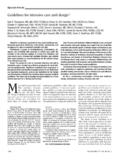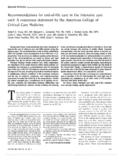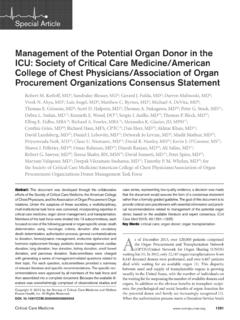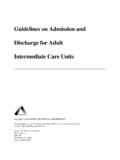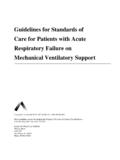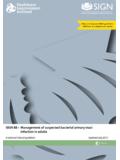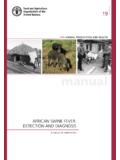Transcription of Clinical Practice Guidelines for the Diagnosis and ...
1 IDSA Guidelines for Intravascular Catheter-Related Infection CID 2009:49 (1 July) 1 IDSA GUIDELINESC linical Practice Guidelines for the Diagnosisand Management of Intravascular Catheter-RelatedInfection: 2009 Update by the Infectious DiseasesSociety of AmericaLeonard A. Mermel,1 Michael Allon,2 Emilio Bouza,9 Donald E. Craven,3 Patricia Flynn,4 Naomi P. O Grady,5 Issam I. Raad,6 Bart J. A. Rijnders,10 Robert J. Sherertz,7and David K. Warren81 Division of Infectious Diseases, Warren Alpert Medical School of Brown University, Providence, Rhode Island;2 University of Alabama-BirminghamHospital, Birmingham, Alabama;3 Tufts University School of Medicine, Lahey Clinic Medical Center, Burlington, Massachusetts;4St.
2 JudeChildren s Research Hospital, Children s Infection Defense Center, Memphis, Tennessee;5 National Institutes of Health, Critical Care MedicineDepartment, Bethesda, Maryland;6 Section of Infectious Diseases, University of Texas-Cancer Center, Houston;7 Section of Infectious Diseases,Wake Forest University School of Medicine, Winston-Salem, North Carolina;8 Division of Infectious Diseases, Washington University Schoolof Medicine, St Louis, Missouri;9 Servicio de Microbiolog a Cli nica y E.
3 Infecciosas Hospital General Gregorio Maran o n, Madrid, Spain;and10 Internal Medicine and Infectious Diseases, Erasmus University Medical Center, Rotterdam, the NetherlandsThese updated Guidelines replace the previous management Guidelines published in 2001. The Guidelines areintended for use by health care providers who care for patients who either have these infections or may beat risk for SUMMARYD iagnosis: Intravenous Catheter cultures should be performed when acatheter is removed for suspected catheter-relatedbloodstream infection (CRBSI); catheter culturesshould not be obtained routinely (A-II).
4 Broth culture of catheter tips is notrecommended (A-II). central venous catheters (CVCs), the catheterReceived 16 March 2009; accepted 18 March 2009; electronically published 2 June is important to realize that Guidelines cannot always account for individualvariation among patients. They are not intended to supplant physician judgmentwith respect to particular patients or special Clinical situations. The IDSA considersadherence to these Guidelines to be voluntary, with the ultimate determinationregarding their application to be made by the physician in the light of each patient sindividual or corresponence: Dr.
5 Leonard Mermel, Div. of Infectious Diseases,Rhode Island Hospital, 593 Eddy St., Providence, RI 02903 Infectious Diseases2009; 49:1 45 2009 by the Infectious Diseases Society of America. All rights $ : should be cultured, rather than the subcutaneoussegment (B-III). cultures of an anti-infective catheter tip, usespecific inhibitors in the culture media (A-II). of115 colony-forming units (cfu) froma 5-cm segment of the catheter tip by semiquantitative(roll-plate) culture or growth of1102cfu from a cath-eter by quantitative (sonication) broth culture reflectscatheter colonization (A-I).
6 Catheter infection is suspected and there isa catheter exit site exudate, swab the drainage to collectspecimens for culture and Gram staining (B-III).Short-term catheters, including arterial short-term catheter tip cultures, the roll platetechnique is recommended for routine Clinical micro-biological analysis (A-II). suspected pulmonary artery catheter infec-tion, culture the introducer tip (A-II).Long-term growth of!15 cfu/plate of thesame microbe from both the insertion site culture and2 CID 2009:49 (1 July) Mermel et for the Diagnosis of acute fever for a patient suspected of having short-term central venous catheter infection or arterial catheterinfection.
7 CFU, colony-forming catheter hub culture strongly suggests that the catheter isnot the source of a bloodstream infection (A-II). a venous access subcutaneous port is removed forsuspected CRBSI, send the port to the microbiology laboratoryfor qualitative culture of the port reservoir contents, in additionto the catheter tip (B-II). Diagnosis : Blood samples for blood culture prior to the initiationof antibiotic therapy (figure 1) (A-I). available, a phlebotomy team should draw theblood samples (A-II).
8 Preparation for obtaining percutaneously drawnblood samples should be performed carefully, with use of ei-ther alcohol or tincture of iodine or alcoholic chlorhexidine( ), rather than povidone-iodine; allow adequate skin con-tact and drying times to mitigate blood culture contamination(A-I). a blood sample is obtained through a catheter, cleanthe catheter hub with either alcohol or tincture of iodine oralcoholic chlorhexidine ( ), allowing adequate drying timeto mitigate blood culture contamination (A-I).
9 suspected CRBSI, paired blood samples, drawn fromthe catheter and a peripheral vein, should be cultured beforeinitiation of antimicrobial therapy, and the bottles should beappropriately marked to reflect the site from which the sampleswere obtained (A-II). a blood sample cannot be drawn from a peripheralvein, it is recommended that 2 blood samples should bedrawn through different catheter lumens (B-III). It is unclearwhether blood cultures should be drawn through all catheterlumens in such circumstances (C-III).
10 Definitive Diagnosis of CRBSI requires that the sameorganism grow from at least 1 percutaneous blood culture andfrom a culture of the catheter tip (A-I), or that 2 blood samplesbe drawn (one from a catheter hub and the other from aperipheral vein) that, when cultured, meet CRBSI criteria forquantitative blood cultures or differential time to positivity(DTP) (A-II). Alternatively, 2 quantitative blood cultures ofsamples obtained through 2 catheter lumens in which the col-ony count for the blood sample drawn through one lumen isat least 3-fold greater than the colony count for the bloodIDSA Guidelines for Intravascular Catheter-Related Infection CID 2009:49 (1 July) 3sample obtained from the second lumen should be consideredto indicate possible CRBSI (B-II).


